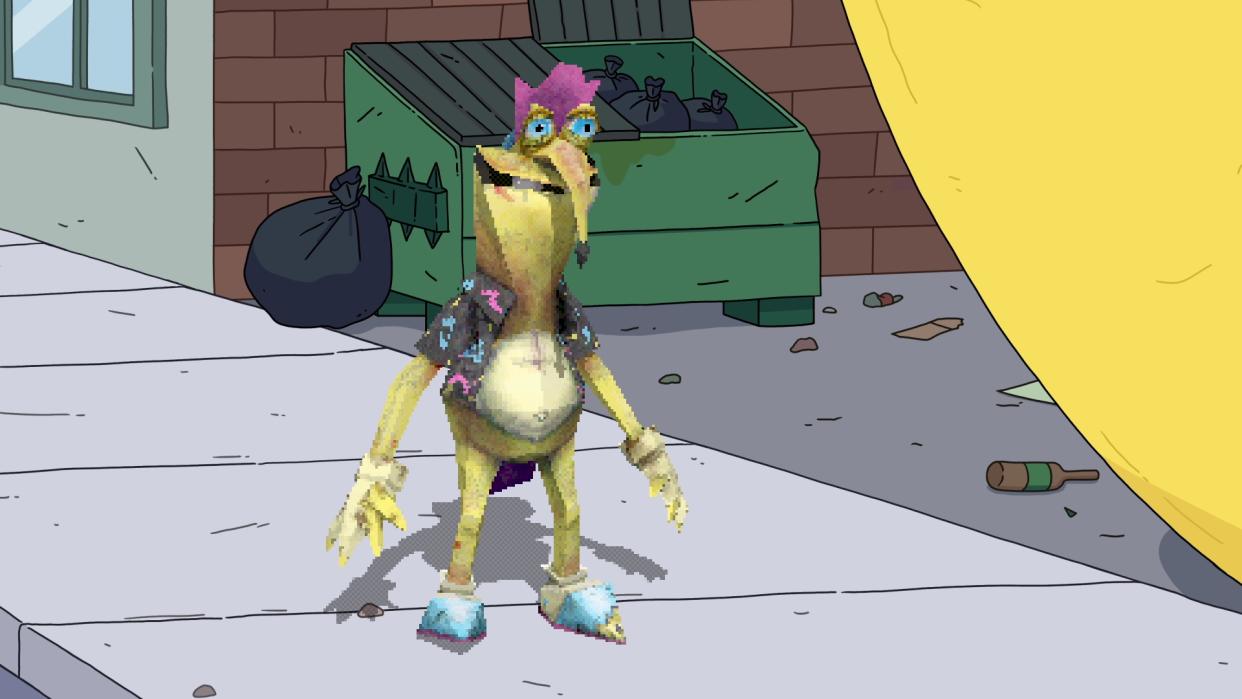‘Sonic Isn’t Actually a Hedgehog’: How ‘Smiling Friends’ Looked to ’90s Video Games to Create Its Weirdest Character Yet

- Oops!Something went wrong.Please try again later.
- Oops!Something went wrong.Please try again later.
- Oops!Something went wrong.Please try again later.
From cancelled celebrity frogs to heartbroken shrimp, the vast “Smiling Friends” universe is home to a lot of strange side characters. But co-creators Michael Cusack and Zach Hadel took things to another level for the Season 2 premiere of their Adult Swim series. The episode, which sports the concise title “Gwimbly: Definitive Remastered Enhanced Extended Edition DX 4K (Anniversary Director’s Cut),” follows the eponymous Smiling Friends as they attempt to cheer up Gwimbly, a beloved ’90s video game character who is unable to star in new games because the evil corporation known as Insane Groundbreaking Games refuses to grant him access to his own I.P.
The episode, which was previewed for fans last month after the network’s puppet-filled April Fool’s prank, is a classic “Smiling Friends” adventure that sees the gang rescue Gwimbly from his sad life of making undignified Cameo videos and help him produce his own independent game. It also features some of the most unique character design that the show has ever seen. Not only is Gwimbly a 3D character living in a 2D world — he was also painstakingly designed by artist Dave “Hoolopee” Post to invoke the crude video game protagonists of the ’90s and early 2000s. In a recent conversation with IndieWire, Hadel and Cusack opened up about folding their passion for old video games into the show.
More from IndieWire
Apple TV+ Is Pitching a New Compensation Model for Creators - Report
'Reservation Dogs' Shows How Great Makeup Can Look Like No Makeup at All
“We didn’t really know what Gwimbly would look like, but we had an idea,” Hadel said, explaining that the character was an homage to the spiky-haired animals of dubious origin that dominated so many video games in the ’90s. “Like, Sonic isn’t really a hedgehog. They say he’s a hedgehog, but that doesn’t look like a hedgehog at all. So we knew Gwimbly would be this vague animal thing.”
Hadel went on to explain that their interest in the character stemmed from their longtime feeling that the fictional video games that exist within movies and TV shows rarely capture the feeling of real games.
“We grew up on ‘90s media, but we felt like we had never personally seen, in movies or television, a truly accurate representation of that era of video games,” he said. “I feel like whenever you’re watching something that has a fake video game in it, it’s always like ‘You die! Level 8!’ That’s not a real game! It feels like something that somebody saw that was also a parody — it’s so far removed.”
Once Post and the team designed Gwimbly as an accurate reflection of the games they grew up on, it was time to integrate him into their bizarre TV world. The character eventually fights another fictional character, the massive robot known as Troglor, in a platform combat game at the end of the episode. The animators said that blending their styles for the combat sequence was a high point of the Gwimbly experiment.
“That’s what excited us from the beginning, getting a Playstation 1 or Nintendo 64-type 3D character from the ‘90s or early 2000s in an episode,” Cusack said. “And seeing him interact with the 2D characters that are already established. And then it was fun to also think, if we’re gonna do the video game aspects, seeing what a high polygon character would look like in that world, how that became Troglor and Super Smash Bros. by the end, seeing different video games interact with each other.”
“Smiling Friends” Season 2 premieres Sunday, April 12 at midnight on Adult Swim.
Best of IndieWire
The Best LGBTQ Movies and TV Shows Streaming on Netflix Right Now
Guillermo del Toro's Favorite Movies: 54 Films the Director Wants You to See
Nicolas Winding Refn's Favorite Films: 37 Movies the Director Wants You to See
Sign up for Indiewire's Newsletter. For the latest news, follow us on Facebook, Twitter, and Instagram.

